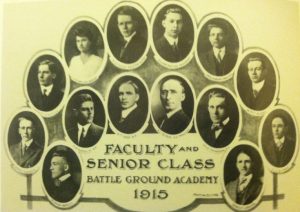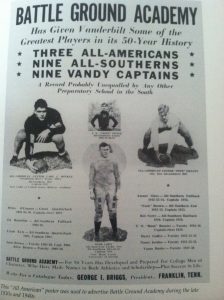The Battle of Franklin stole so many young southern men’s lives.
What better place, 20 years later, than to build the first Battle Ground Academy- that would give the youth of Franklin a future the war robbed from their fathers and grandfathers.
Battle Ground Academy (BGA) today sits along Mack Hatcher Parkway in Franklin, about a quarter of a mile from Hillsboro Road.
But that is the third BGA. The first went up in 1889 where the cotton gin used to be, right on the battlefield from the Battle of Franklin.
BGA had bad luck with fires, said Heritage Foundation of Franklin historian Rick Warwick. The first one burned down in 1902. That is when it moved across the street to what had been Thomas Carter’s land and where it stayed for almost a century. Then in 2003 the school made the final move to its current location.
As new schools go up where the old one was, it is a good time to look back at the history of that location after the Civil War.
Efforts for public education in the area date back to 1806 when Harpeth Academy was opened in 1811. By 1889, local citizens had decided to start a school to provide the most current education opportunities for their children.
That year a group of local citizens came together to create a school that was “entirely non-sectarian, yet sound morals, good citizenship and Christianity will be its corner stone,” wrote Cindy Gentry in Battle Ground Academy: A Monument to Education.
Stockholders bought six acres of land from Moscow Carter, for $1,140, in July 1889- and BGA was born. But its first name was the Wall and Mooney school. It was located on the east side of Columbia Pike, just south of where Bunganut Pig is located
Simeon Wall was a veteren of the 80th Tennessee Regiment of the Confederate army who studied education after the war and founded and ran the school with William Mooney.
Mooney, valedictorian in his class at Southwestern Presbyterian University, was the arithmetic, English, Latin and Greek master at the school, as well as an athletic coach. In a sentiment well before its time, he vehemently opposed the use of tobacco and alcohol. He even wrote to a prospective parent “cigarette fiends not wanted,” writes Gentry.
In the first ten years, the school excelled. The student body ranged from 80 to 120 and, though a majority were male, “a few outstanding young ladies” also attended, notes Gentry.
 The first football team was organized in 1891- using heavy khaki canvas with cotton padding for protection. The team was so good that Mooney
The first football team was organized in 1891- using heavy khaki canvas with cotton padding for protection. The team was so good that Mooney
reportedly offered $500 to anyone who could convince the Vanderbilt team to face them on gridiron. Baseball, tennis and other sports followed.
The school continued to grow and succeed until 1902. The school year came to an abrupt halt when it burned to ground. Instead of rebuilding there, Mooney decided to move to Murfreesboro. Not wanting to lose what had been a great local school, the community once again rallied to create what would be known as the Peoples School, after R.G. “Daddy” Peoples- headmaster from 1903 to 1925. The school then moved across Columbia Pike, to where the Senior Enrichment Center is being built and where Renaissance High School is.
Again, the new school quickly filled in the shoes of the old one. Until, in 1910, fire again burned.
On the evening of March 3, according to The Review Appeal, a man passing the school at 11:00 p.m. saw a blaze

coming from the main building and ran to get help. The following morning all that was left standing were the exterior walls. Lost in the fire were private papers, records and a valuable library, which was insured for only $500. Overall the school recouped $7,500.
They wasted no time, however, laying plans for a newer, better school. Withing a week of the fire, a $10,000 campus was planned.
The new Peoples School flourished. More than 10 daily trains came through Franklin, billed as one of the healthiest towns in the state. Tuition in 1930 was $125 for day students and $650 for boarding students.
It became known as Battle Ground Academy- for its location right on and by the old Carter land.
At the new campus, the school adapted and changed with times, but always maintained its core values. In the ’50s there was an underground newspaper called, so apropos of the era, The Hep Cat. By 1979, the school had added both soccer and became a co-ed school.
In 2003, after more than 100 years on the land where the Battle of Franklin raged, the school relocated to a larger campus on Mack Hatcher Parkway. The Williamson County government purchased the campus as the site for the new Public Library and to use the former school gymnasium for Parks and Recreation programs.
[gap height=”20″]
[scroller style=”sc1″ title=”More History” title_size=”17″ number_of_posts=”4″ speed=”300″]


















